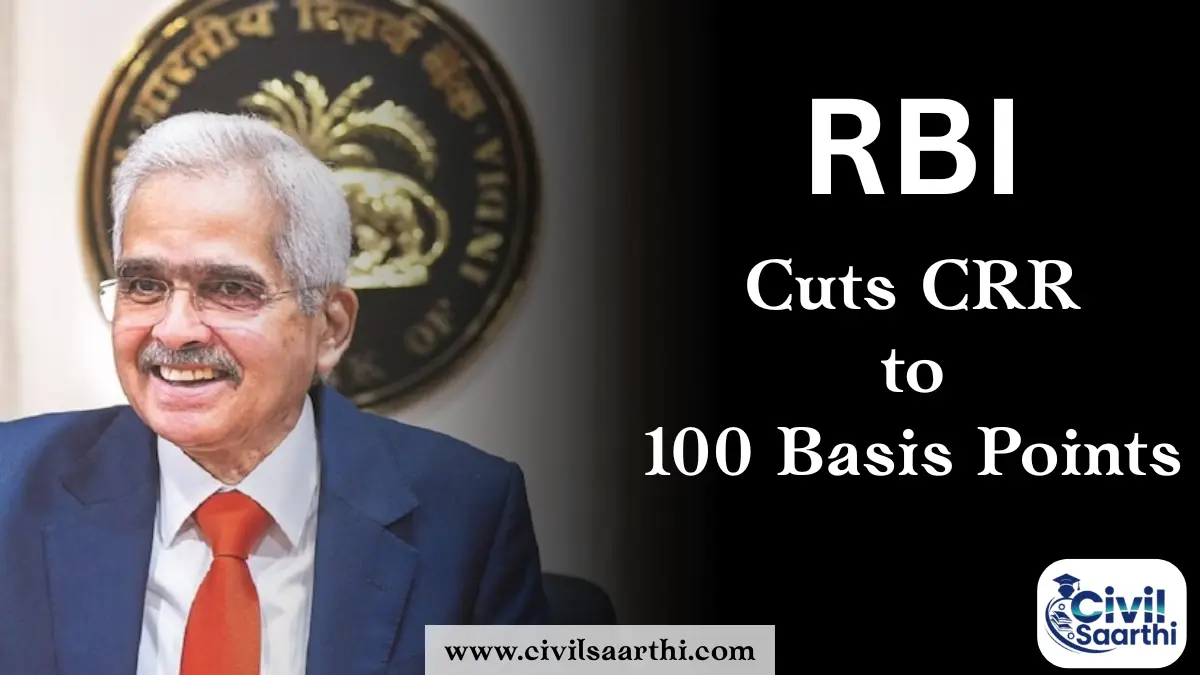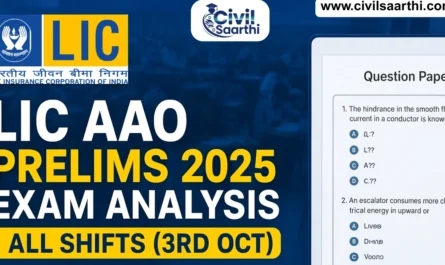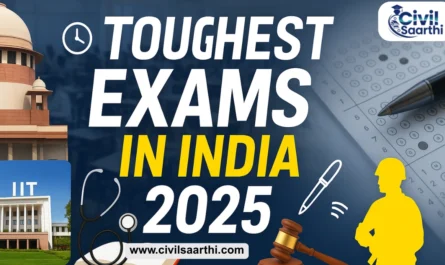The Reserve Bank of India (RBI), during the Monetary Policy Committee (MPC) meeting held on June 6, 2025, announced a significant decision to cut the Cash Reserve Ratio (CRR) by 100 basis points. This strategic move comes at a time when the Indian economy is seeking liquidity support amid slowing private investments and global economic uncertainty. The phased CRR cut, along with a 50 basis point reduction in the repo rate, has important implications for the banking sector, financial markets, and overall macroeconomic stability.
What is Cash Reserve Ratio (CRR)?
- CRR is the percentage of a commercial bank’s total deposits that it must hold as reserves with the RBI.
- These reserves are held in cash and do not earn any interest.
- The CRR is used by the RBI as a tool to control liquidity in the banking system.
Why Did RBI Cut the CRR in 2025?
- The RBI decided to reduce the CRR by 100 basis points in a phased manner.
- This will lower the CRR from the existing 4% to 3% by December 2025.
- The move is aimed at injecting durable liquidity into the banking system.
- It allows banks to lend more by freeing up an estimated ₹2.5 lakh crore.
- The RBI Governor stated that the cut would help reduce funding costs and improve transmission of monetary policy.
Key Takeaways from the MPC Meeting
- CRR Cut: 100 basis points reduction by December 2025 in four equal phases of 25 bps.
- Repo Rate Cut: 50 basis points reduction; current repo rate stands at 5.5%.
- Policy Stance: Changed from ‘accommodative’ to ‘neutral’, indicating cautious optimism.
- Liquidity Management: RBI aims to support economic growth without triggering inflation.
- Focus Sectors: Emphasis on affordable housing, MSMEs, agriculture, and rural development.
How CRR Cut Affects the Banking Sector
- Banks have more funds available to lend.
- Reduces the cost of funds for banks.
- Enhances credit flow to productive sectors.
- May improve Net Interest Margins (NIMs) of banks.
- Encourages greater financial intermediation.
Impact on Indian Economy
- Stimulates investment and consumption.
- Supports small businesses through increased credit access.
- Boosts demand in the real estate and infrastructure sectors.
- Helps control liquidity during global monetary tightening.
- Can reduce cost of borrowing for individuals and corporates.
Positive Market Reaction
- Indian stock markets responded with gains post-MPC announcement.
- Banking, real estate, and NBFC stocks witnessed upward momentum.
- Investor sentiment improved due to expectations of higher earnings and growth.
Challenges Ahead
- Risk of inflation if excess liquidity is not absorbed effectively.
- Transmission of rate cuts may be delayed by banks cautious of rising NPAs.
- Global uncertainties and imported inflation could limit benefits.
- RBI needs to balance growth with financial stability.
Strategic Importance of CRR as a Monetary Tool
- Acts as a quantitative measure to control liquidity.
- Unlike the repo rate, CRR directly affects the amount of lendable resources.
- Useful during economic slowdowns and credit squeezes.
- Reducing CRR can provide immediate liquidity support.
Role of RBI in Liquidity Management
- Uses multiple tools: CRR, SLR, repo rate, reverse repo rate, OMOs.
- Liquidity infusion is calibrated to prevent overheating of the economy.
- RBI’s neutral stance signals flexible policy adjustments in future
UPSC Mains Question (GS Paper 3)
- Discuss the role of the Cash Reserve Ratio (CRR) as a monetary policy tool. Examine the implications of a CRR cut on the Indian banking sector and overall economic activity. (250 words)
UPSC Prelims PYQs
Que. The money multiplier in an economy increases with which one of the following? [2021]
- a) Increase in the cash Reserve Ratio in the banks
- b) Increase in the Statutory Liquidity Ratio in the banks
- c) Increase in the banking habit of the people
- d) Increase in the population of the country
Ans c
Que. If the RBI decides to adopt an expansionist monetary policy, which of the following would it not do? [2020]
- Cut and optimize the Statutory Liquidity Ratio
- Increase the Marginal Standing Facility Rate
- Cut the Bank Rate and Repo Rate
Select the correct answer using the code given below:
- a) 1 and 2 only
- b) 2 only
- c) 1 and 3 only
- d) 1, 2 and 3
Ans b
Cash Reserve Ratio CRR FAQs
Q1. What is the Cash Reserve Ratio (CRR) in India?
Answer: The Cash Reserve Ratio (CRR) is the percentage of a commercial bank’s total deposits that must be maintained as reserves with the Reserve Bank of India.
Q2. Why did the RBI reduce the CRR in 2025?
Answer: The RBI reduced the CRR by 100 basis points in 2025 to inject liquidity into the banking system, encourage lending, and support economic recovery.
Q3. How does a CRR cut affect the economy?
Answer: A CRR cut increases the amount of funds available for banks to lend, lowers borrowing costs, stimulates investment and consumer spending, and boosts overall economic growth.
Q4. What is the difference between CRR and SLR?
Answer: CRR (Cash Reserve Ratio) requires banks to keep a portion of their deposits as cash with the RBI, whereas SLR (Statutory Liquidity Ratio) mandates banks to maintain a specified percentage of their deposits in the form of government-approved securities.
Q5. What does a 100 basis point CRR cut mean?
Answer: A 100 basis point CRR cut means the CRR is reduced by 1%. For instance, if CRR was 4%, a 100 basis point reduction would bring it down to 3%. This cut increases the funds banks can use for lending and investment.
Q6. Will the CRR cut lead to lower interest rates for borrowers?
Answer: Yes, a lower CRR reduces the cost of funds for banks, which can lead to lower lending rates for borrowers, provided banks pass on the benefit.
Q7. What is the repo rate and how does it relate to the CRR?
Answer: The repo rate is the rate at which the RBI lends money to commercial banks. While CRR controls liquidity directly, the repo rate influences the cost of borrowing. Both are monetary tools used to manage inflation, liquidity, and economic growth.
Q8. What was the RBI’s policy stance in the June 2025 MPC meeting?
Answer: In the June 2025 MPC meeting, the RBI changed its policy stance from “accommodative” to “neutral”, signaling a shift to a more balanced and data-driven approach.
Q9. Is the CRR cut a permanent move?
Answer: No, CRR adjustments are based on prevailing economic conditions. The RBI may revise the CRR upward or downward depending on inflation trends, liquidity needs, and macroeconomic stability.
Q10. How can UPSC aspirants prepare CRR-related topics?
Answer: Aspirants should study CRR and other monetary policy tools under Indian Economy for GS Paper 3. Focus on recent RBI decisions, their impact on inflation and growth, and relate them to static concepts.







